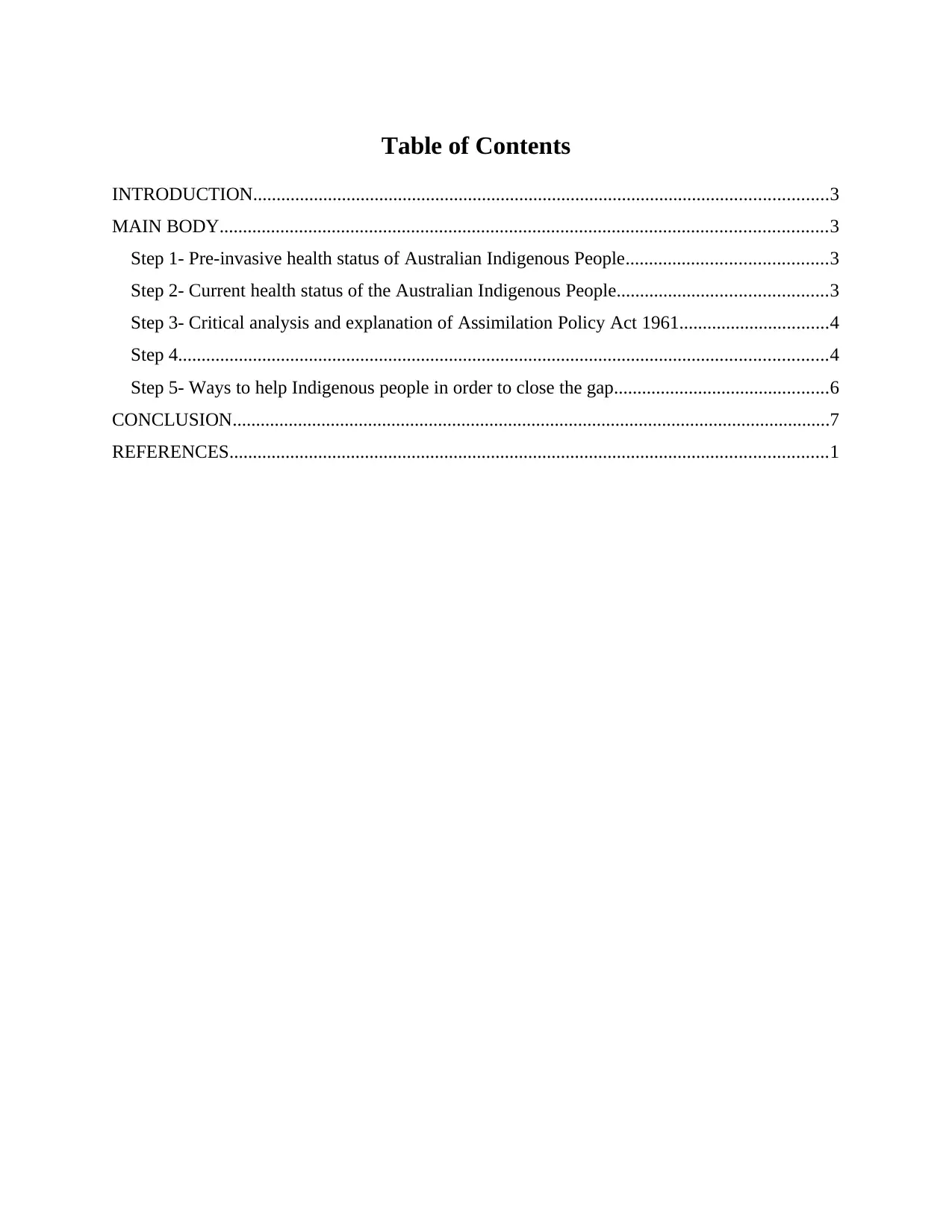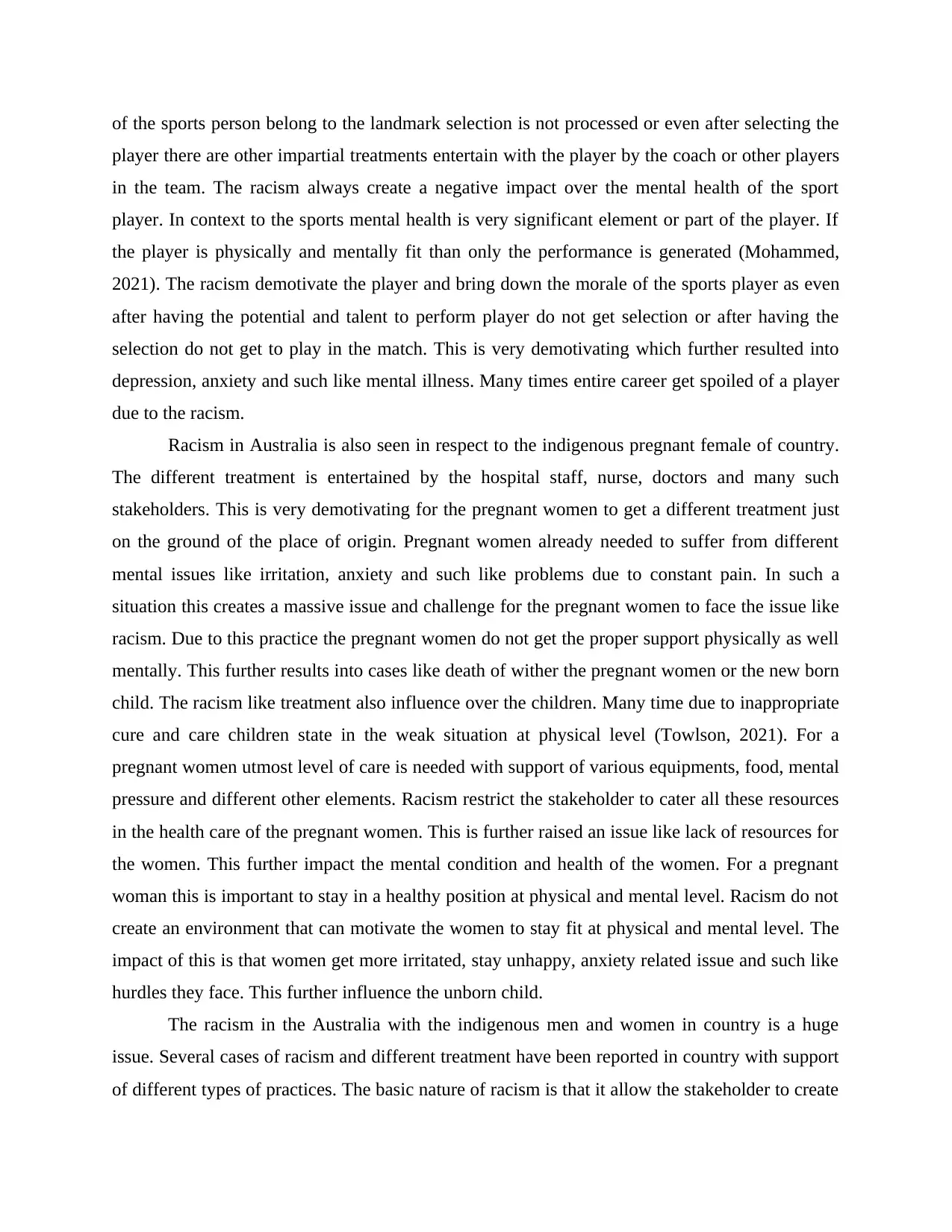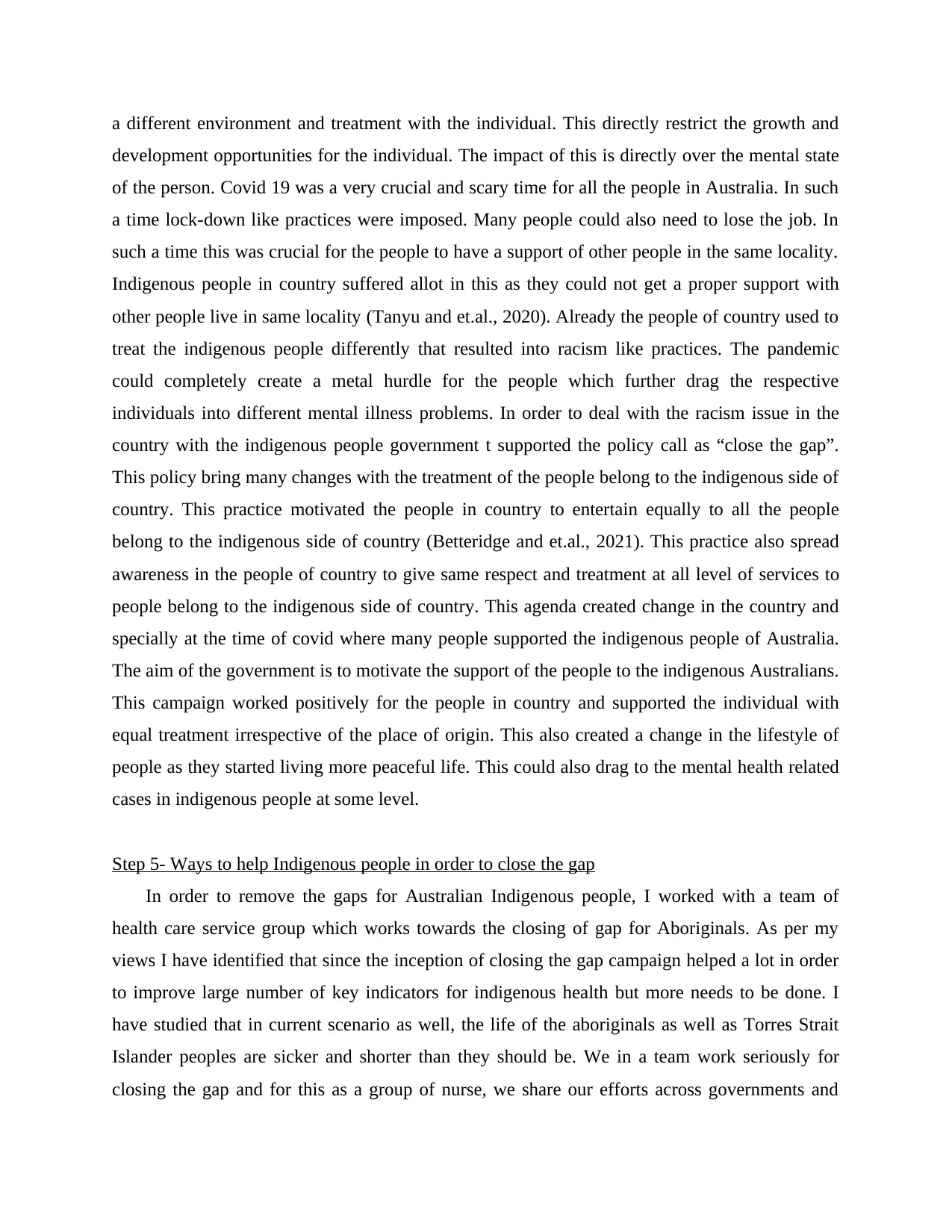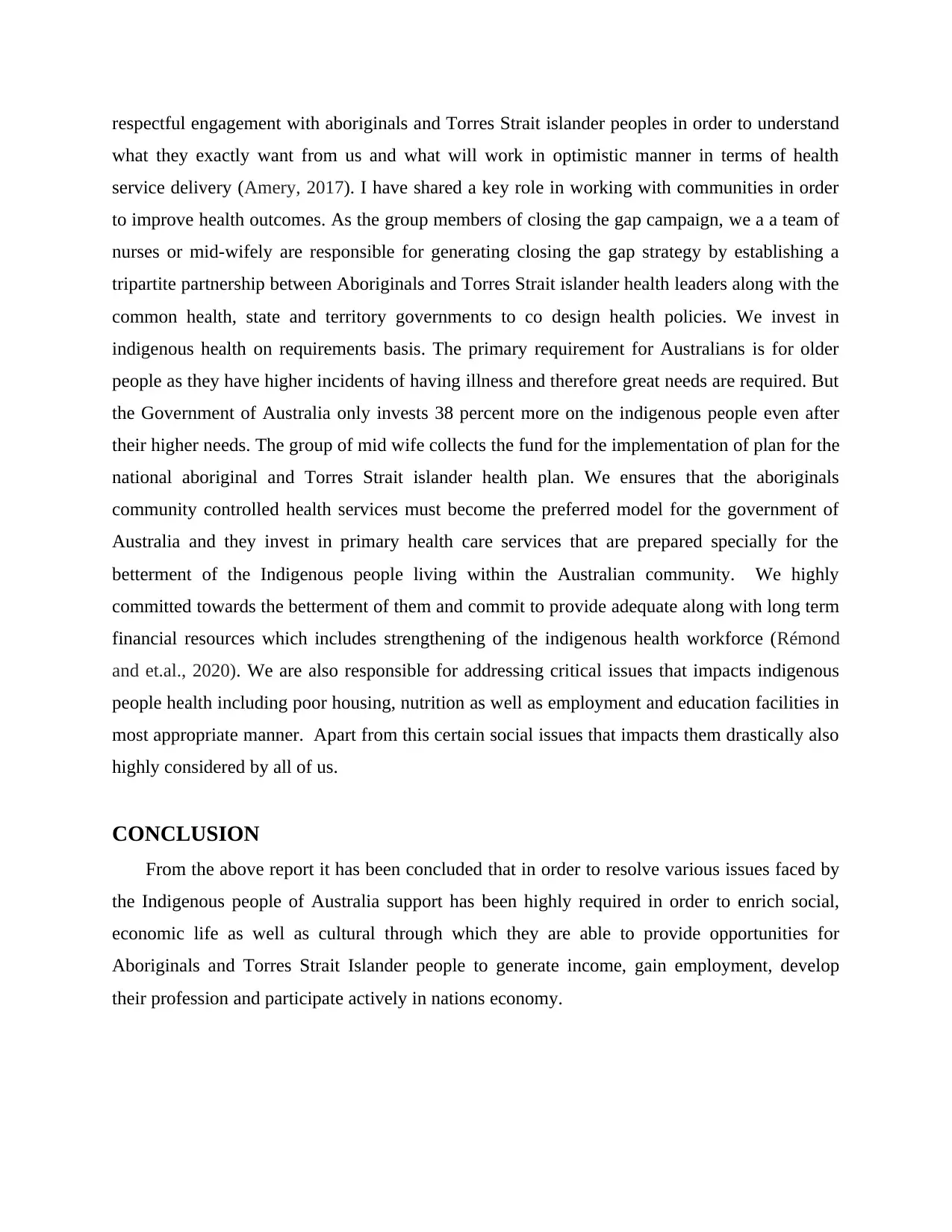NUR332: Assimilation Policy 1961 & Indigenous Health in Australia
VerifiedAdded on 2023/06/18
|9
|2623
|239
Essay
AI Summary
This essay examines the impact of the Assimilation Policy Act 1961 on the health of Australian Indigenous men and women. It discusses the pre-invasive and current health status of Indigenous Australians, highlighting disparities compared to non-Indigenous Australians. The essay analyzes how the Assimilation Policy, aimed at absorbing Aboriginal people into white society, led to the loss of rights, family separation, and cultural identity. It further explores the impact of racism in sports and healthcare, particularly for pregnant women, and the challenges faced during the COVID-19 pandemic. The essay concludes by discussing the "Close the Gap" initiative and ways to improve Indigenous health outcomes through collaborative efforts, targeted investments, and strengthening Indigenous health services, with Desklib providing access to similar essays and study resources.

AUSTRALIAN
INDIGENOUS MEN AND
WOMEN
INDIGENOUS MEN AND
WOMEN
Paraphrase This Document
Need a fresh take? Get an instant paraphrase of this document with our AI Paraphraser

Table of Contents
INTRODUCTION...........................................................................................................................3
MAIN BODY..................................................................................................................................3
Step 1- Pre-invasive health status of Australian Indigenous People...........................................3
Step 2- Current health status of the Australian Indigenous People.............................................3
Step 3- Critical analysis and explanation of Assimilation Policy Act 1961................................4
Step 4...........................................................................................................................................4
Step 5- Ways to help Indigenous people in order to close the gap..............................................6
CONCLUSION................................................................................................................................7
REFERENCES................................................................................................................................1
INTRODUCTION...........................................................................................................................3
MAIN BODY..................................................................................................................................3
Step 1- Pre-invasive health status of Australian Indigenous People...........................................3
Step 2- Current health status of the Australian Indigenous People.............................................3
Step 3- Critical analysis and explanation of Assimilation Policy Act 1961................................4
Step 4...........................................................................................................................................4
Step 5- Ways to help Indigenous people in order to close the gap..............................................6
CONCLUSION................................................................................................................................7
REFERENCES................................................................................................................................1

INTRODUCTION
Ingenuous Australia are meant by the different indigenous citizens of Australia belong to the
mainland and many of its island that include Tasmania, Fraser Island, Hinchinbrook Island,
he Tiwi Island and Groote Eylandt. This project will discuss the impact of health policies in
Australia created for the indigenous people. Current health status of Australia indigenous
people will also discuss. Impact of racism over different aspects of indigenous people in
Australia will also discuss in this project.
MAIN BODY
Step 1- Pre-invasive health status of Australian Indigenous People
Indigenous Australians are more likely to face mental health problems and chronic diseases
such as respiratory diseases, cardiovascular issues, chronic kidney disease and diabetes than non-
indigenous Australians. Various researches have been share the statistics that life expectancy for
indigenous Australians was estimated to 71 years for males and 75 years for females. The reason
behind their poor health problems as compared to non-indigenous complement the experience of
colonisation along with long term effects of being colonised has caused inequalities in
indigenous health status which includes social, emotional, physical and mental health (Molloy
and et.al., 2019).
Step 2- Current health status of the Australian Indigenous People
Aboriginals and Torres Strait Islander people are the Indigenous people of Australia. They
are not just one group but consist of hundreds of groups that have their own distinct set of
languages and cultural traditions. Currently, it has been identified that Indigenous Australians are
estimated as 67% which is around 545300 people are reported for long term health issues
(Hanson and et.al., 2020). Apart from this 40% i.e. 307400 people are reported for sight
problems or various challenges related to eyes. 25% Indigenous Australians are recorded for
having mental health as well as behavioural issues through which they are not able to
appropriately handle their day to day life as well.
Ingenuous Australia are meant by the different indigenous citizens of Australia belong to the
mainland and many of its island that include Tasmania, Fraser Island, Hinchinbrook Island,
he Tiwi Island and Groote Eylandt. This project will discuss the impact of health policies in
Australia created for the indigenous people. Current health status of Australia indigenous
people will also discuss. Impact of racism over different aspects of indigenous people in
Australia will also discuss in this project.
MAIN BODY
Step 1- Pre-invasive health status of Australian Indigenous People
Indigenous Australians are more likely to face mental health problems and chronic diseases
such as respiratory diseases, cardiovascular issues, chronic kidney disease and diabetes than non-
indigenous Australians. Various researches have been share the statistics that life expectancy for
indigenous Australians was estimated to 71 years for males and 75 years for females. The reason
behind their poor health problems as compared to non-indigenous complement the experience of
colonisation along with long term effects of being colonised has caused inequalities in
indigenous health status which includes social, emotional, physical and mental health (Molloy
and et.al., 2019).
Step 2- Current health status of the Australian Indigenous People
Aboriginals and Torres Strait Islander people are the Indigenous people of Australia. They
are not just one group but consist of hundreds of groups that have their own distinct set of
languages and cultural traditions. Currently, it has been identified that Indigenous Australians are
estimated as 67% which is around 545300 people are reported for long term health issues
(Hanson and et.al., 2020). Apart from this 40% i.e. 307400 people are reported for sight
problems or various challenges related to eyes. 25% Indigenous Australians are recorded for
having mental health as well as behavioural issues through which they are not able to
appropriately handle their day to day life as well.
⊘ This is a preview!⊘
Do you want full access?
Subscribe today to unlock all pages.

Trusted by 1+ million students worldwide

Step 3- Critical analysis and explanation of Assimilation Policy Act 1961
The Assimilation Policy Act 1961 was a policy of absorbing Aboriginal people into white
society through the procedure of removing children from their families. The ultimate intention of
this particular policy was the destruction of Aboriginal society. This policy intends to provide all
aboriginals and part aboriginals are expected to attain the similar manner of living as other
Australians and live their life as single Australian community with enjoying similar rights and
privileges (Black, Toombs and Kisely, 2018). Through various researches the Assimilation
Policy had largest impact upon Indigenous Australians such as the Aboriginals losing their rights
to freedom, Aboriginal children being removed from their families and finally they loss their
aboriginality within the society.
Step 4
Indigenous people in Australia belong to the various island attached alongside to the
geological location of country. In case of the country the majority of sports professionals come
from the main stream based in Australia. There are many islands that are also associated with the
country. When it comes to sports many times the people belong to the different alongside island
of country feel separated from the main part of the country. Racism is defined as creating a
different treatment to the person contain same or similar eligibility by catering or delegating the
power or position. When it comes to sports Australia is very developed as the country is doing
well all across the formats of sporting events not only at the regional; level but also
internationally as well (Miller, 2021). The selection in sports is very significant and crucial.
There are many incidents have been reported where the racism is seemed to be entertain in
respect to the indigenous sports players in country. The proportion of the number of player come
from the indigenous background in Australia is very less as compare to the sports professionals
come from the main stream of the country. Although there are plenty of sports players belong to
the indigenous side of Australia that include Fred Agius, Gordon Briscoe and many other belong
to the Soccer game. Lynch Cooper, Robert Crowther and many such players in athletics and
various other players belong to different other sporting fields are associated with the team.
Although the presence of number of players get selected in the men sporting events of country
(Ford and et.al., 2021). There are plenty of cases have been reported where racism is identified at
the time of selection of different indigenous sports players of country. Many times just because
The Assimilation Policy Act 1961 was a policy of absorbing Aboriginal people into white
society through the procedure of removing children from their families. The ultimate intention of
this particular policy was the destruction of Aboriginal society. This policy intends to provide all
aboriginals and part aboriginals are expected to attain the similar manner of living as other
Australians and live their life as single Australian community with enjoying similar rights and
privileges (Black, Toombs and Kisely, 2018). Through various researches the Assimilation
Policy had largest impact upon Indigenous Australians such as the Aboriginals losing their rights
to freedom, Aboriginal children being removed from their families and finally they loss their
aboriginality within the society.
Step 4
Indigenous people in Australia belong to the various island attached alongside to the
geological location of country. In case of the country the majority of sports professionals come
from the main stream based in Australia. There are many islands that are also associated with the
country. When it comes to sports many times the people belong to the different alongside island
of country feel separated from the main part of the country. Racism is defined as creating a
different treatment to the person contain same or similar eligibility by catering or delegating the
power or position. When it comes to sports Australia is very developed as the country is doing
well all across the formats of sporting events not only at the regional; level but also
internationally as well (Miller, 2021). The selection in sports is very significant and crucial.
There are many incidents have been reported where the racism is seemed to be entertain in
respect to the indigenous sports players in country. The proportion of the number of player come
from the indigenous background in Australia is very less as compare to the sports professionals
come from the main stream of the country. Although there are plenty of sports players belong to
the indigenous side of Australia that include Fred Agius, Gordon Briscoe and many other belong
to the Soccer game. Lynch Cooper, Robert Crowther and many such players in athletics and
various other players belong to different other sporting fields are associated with the team.
Although the presence of number of players get selected in the men sporting events of country
(Ford and et.al., 2021). There are plenty of cases have been reported where racism is identified at
the time of selection of different indigenous sports players of country. Many times just because
Paraphrase This Document
Need a fresh take? Get an instant paraphrase of this document with our AI Paraphraser

of the sports person belong to the landmark selection is not processed or even after selecting the
player there are other impartial treatments entertain with the player by the coach or other players
in the team. The racism always create a negative impact over the mental health of the sport
player. In context to the sports mental health is very significant element or part of the player. If
the player is physically and mentally fit than only the performance is generated (Mohammed,
2021). The racism demotivate the player and bring down the morale of the sports player as even
after having the potential and talent to perform player do not get selection or after having the
selection do not get to play in the match. This is very demotivating which further resulted into
depression, anxiety and such like mental illness. Many times entire career get spoiled of a player
due to the racism.
Racism in Australia is also seen in respect to the indigenous pregnant female of country.
The different treatment is entertained by the hospital staff, nurse, doctors and many such
stakeholders. This is very demotivating for the pregnant women to get a different treatment just
on the ground of the place of origin. Pregnant women already needed to suffer from different
mental issues like irritation, anxiety and such like problems due to constant pain. In such a
situation this creates a massive issue and challenge for the pregnant women to face the issue like
racism. Due to this practice the pregnant women do not get the proper support physically as well
mentally. This further results into cases like death of wither the pregnant women or the new born
child. The racism like treatment also influence over the children. Many time due to inappropriate
cure and care children state in the weak situation at physical level (Towlson, 2021). For a
pregnant women utmost level of care is needed with support of various equipments, food, mental
pressure and different other elements. Racism restrict the stakeholder to cater all these resources
in the health care of the pregnant women. This is further raised an issue like lack of resources for
the women. This further impact the mental condition and health of the women. For a pregnant
woman this is important to stay in a healthy position at physical and mental level. Racism do not
create an environment that can motivate the women to stay fit at physical and mental level. The
impact of this is that women get more irritated, stay unhappy, anxiety related issue and such like
hurdles they face. This further influence the unborn child.
The racism in the Australia with the indigenous men and women in country is a huge
issue. Several cases of racism and different treatment have been reported in country with support
of different types of practices. The basic nature of racism is that it allow the stakeholder to create
player there are other impartial treatments entertain with the player by the coach or other players
in the team. The racism always create a negative impact over the mental health of the sport
player. In context to the sports mental health is very significant element or part of the player. If
the player is physically and mentally fit than only the performance is generated (Mohammed,
2021). The racism demotivate the player and bring down the morale of the sports player as even
after having the potential and talent to perform player do not get selection or after having the
selection do not get to play in the match. This is very demotivating which further resulted into
depression, anxiety and such like mental illness. Many times entire career get spoiled of a player
due to the racism.
Racism in Australia is also seen in respect to the indigenous pregnant female of country.
The different treatment is entertained by the hospital staff, nurse, doctors and many such
stakeholders. This is very demotivating for the pregnant women to get a different treatment just
on the ground of the place of origin. Pregnant women already needed to suffer from different
mental issues like irritation, anxiety and such like problems due to constant pain. In such a
situation this creates a massive issue and challenge for the pregnant women to face the issue like
racism. Due to this practice the pregnant women do not get the proper support physically as well
mentally. This further results into cases like death of wither the pregnant women or the new born
child. The racism like treatment also influence over the children. Many time due to inappropriate
cure and care children state in the weak situation at physical level (Towlson, 2021). For a
pregnant women utmost level of care is needed with support of various equipments, food, mental
pressure and different other elements. Racism restrict the stakeholder to cater all these resources
in the health care of the pregnant women. This is further raised an issue like lack of resources for
the women. This further impact the mental condition and health of the women. For a pregnant
woman this is important to stay in a healthy position at physical and mental level. Racism do not
create an environment that can motivate the women to stay fit at physical and mental level. The
impact of this is that women get more irritated, stay unhappy, anxiety related issue and such like
hurdles they face. This further influence the unborn child.
The racism in the Australia with the indigenous men and women in country is a huge
issue. Several cases of racism and different treatment have been reported in country with support
of different types of practices. The basic nature of racism is that it allow the stakeholder to create

a different environment and treatment with the individual. This directly restrict the growth and
development opportunities for the individual. The impact of this is directly over the mental state
of the person. Covid 19 was a very crucial and scary time for all the people in Australia. In such
a time lock-down like practices were imposed. Many people could also need to lose the job. In
such a time this was crucial for the people to have a support of other people in the same locality.
Indigenous people in country suffered allot in this as they could not get a proper support with
other people live in same locality (Tanyu and et.al., 2020). Already the people of country used to
treat the indigenous people differently that resulted into racism like practices. The pandemic
could completely create a metal hurdle for the people which further drag the respective
individuals into different mental illness problems. In order to deal with the racism issue in the
country with the indigenous people government t supported the policy call as “close the gap”.
This policy bring many changes with the treatment of the people belong to the indigenous side of
country. This practice motivated the people in country to entertain equally to all the people
belong to the indigenous side of country (Betteridge and et.al., 2021). This practice also spread
awareness in the people of country to give same respect and treatment at all level of services to
people belong to the indigenous side of country. This agenda created change in the country and
specially at the time of covid where many people supported the indigenous people of Australia.
The aim of the government is to motivate the support of the people to the indigenous Australians.
This campaign worked positively for the people in country and supported the individual with
equal treatment irrespective of the place of origin. This also created a change in the lifestyle of
people as they started living more peaceful life. This could also drag to the mental health related
cases in indigenous people at some level.
Step 5- Ways to help Indigenous people in order to close the gap
In order to remove the gaps for Australian Indigenous people, I worked with a team of
health care service group which works towards the closing of gap for Aboriginals. As per my
views I have identified that since the inception of closing the gap campaign helped a lot in order
to improve large number of key indicators for indigenous health but more needs to be done. I
have studied that in current scenario as well, the life of the aboriginals as well as Torres Strait
Islander peoples are sicker and shorter than they should be. We in a team work seriously for
closing the gap and for this as a group of nurse, we share our efforts across governments and
development opportunities for the individual. The impact of this is directly over the mental state
of the person. Covid 19 was a very crucial and scary time for all the people in Australia. In such
a time lock-down like practices were imposed. Many people could also need to lose the job. In
such a time this was crucial for the people to have a support of other people in the same locality.
Indigenous people in country suffered allot in this as they could not get a proper support with
other people live in same locality (Tanyu and et.al., 2020). Already the people of country used to
treat the indigenous people differently that resulted into racism like practices. The pandemic
could completely create a metal hurdle for the people which further drag the respective
individuals into different mental illness problems. In order to deal with the racism issue in the
country with the indigenous people government t supported the policy call as “close the gap”.
This policy bring many changes with the treatment of the people belong to the indigenous side of
country. This practice motivated the people in country to entertain equally to all the people
belong to the indigenous side of country (Betteridge and et.al., 2021). This practice also spread
awareness in the people of country to give same respect and treatment at all level of services to
people belong to the indigenous side of country. This agenda created change in the country and
specially at the time of covid where many people supported the indigenous people of Australia.
The aim of the government is to motivate the support of the people to the indigenous Australians.
This campaign worked positively for the people in country and supported the individual with
equal treatment irrespective of the place of origin. This also created a change in the lifestyle of
people as they started living more peaceful life. This could also drag to the mental health related
cases in indigenous people at some level.
Step 5- Ways to help Indigenous people in order to close the gap
In order to remove the gaps for Australian Indigenous people, I worked with a team of
health care service group which works towards the closing of gap for Aboriginals. As per my
views I have identified that since the inception of closing the gap campaign helped a lot in order
to improve large number of key indicators for indigenous health but more needs to be done. I
have studied that in current scenario as well, the life of the aboriginals as well as Torres Strait
Islander peoples are sicker and shorter than they should be. We in a team work seriously for
closing the gap and for this as a group of nurse, we share our efforts across governments and
⊘ This is a preview!⊘
Do you want full access?
Subscribe today to unlock all pages.

Trusted by 1+ million students worldwide

respectful engagement with aboriginals and Torres Strait islander peoples in order to understand
what they exactly want from us and what will work in optimistic manner in terms of health
service delivery (Amery, 2017). I have shared a key role in working with communities in order
to improve health outcomes. As the group members of closing the gap campaign, we a a team of
nurses or mid-wifely are responsible for generating closing the gap strategy by establishing a
tripartite partnership between Aboriginals and Torres Strait islander health leaders along with the
common health, state and territory governments to co design health policies. We invest in
indigenous health on requirements basis. The primary requirement for Australians is for older
people as they have higher incidents of having illness and therefore great needs are required. But
the Government of Australia only invests 38 percent more on the indigenous people even after
their higher needs. The group of mid wife collects the fund for the implementation of plan for the
national aboriginal and Torres Strait islander health plan. We ensures that the aboriginals
community controlled health services must become the preferred model for the government of
Australia and they invest in primary health care services that are prepared specially for the
betterment of the Indigenous people living within the Australian community. We highly
committed towards the betterment of them and commit to provide adequate along with long term
financial resources which includes strengthening of the indigenous health workforce (Rémond
and et.al., 2020). We are also responsible for addressing critical issues that impacts indigenous
people health including poor housing, nutrition as well as employment and education facilities in
most appropriate manner. Apart from this certain social issues that impacts them drastically also
highly considered by all of us.
CONCLUSION
From the above report it has been concluded that in order to resolve various issues faced by
the Indigenous people of Australia support has been highly required in order to enrich social,
economic life as well as cultural through which they are able to provide opportunities for
Aboriginals and Torres Strait Islander people to generate income, gain employment, develop
their profession and participate actively in nations economy.
what they exactly want from us and what will work in optimistic manner in terms of health
service delivery (Amery, 2017). I have shared a key role in working with communities in order
to improve health outcomes. As the group members of closing the gap campaign, we a a team of
nurses or mid-wifely are responsible for generating closing the gap strategy by establishing a
tripartite partnership between Aboriginals and Torres Strait islander health leaders along with the
common health, state and territory governments to co design health policies. We invest in
indigenous health on requirements basis. The primary requirement for Australians is for older
people as they have higher incidents of having illness and therefore great needs are required. But
the Government of Australia only invests 38 percent more on the indigenous people even after
their higher needs. The group of mid wife collects the fund for the implementation of plan for the
national aboriginal and Torres Strait islander health plan. We ensures that the aboriginals
community controlled health services must become the preferred model for the government of
Australia and they invest in primary health care services that are prepared specially for the
betterment of the Indigenous people living within the Australian community. We highly
committed towards the betterment of them and commit to provide adequate along with long term
financial resources which includes strengthening of the indigenous health workforce (Rémond
and et.al., 2020). We are also responsible for addressing critical issues that impacts indigenous
people health including poor housing, nutrition as well as employment and education facilities in
most appropriate manner. Apart from this certain social issues that impacts them drastically also
highly considered by all of us.
CONCLUSION
From the above report it has been concluded that in order to resolve various issues faced by
the Indigenous people of Australia support has been highly required in order to enrich social,
economic life as well as cultural through which they are able to provide opportunities for
Aboriginals and Torres Strait Islander people to generate income, gain employment, develop
their profession and participate actively in nations economy.
Paraphrase This Document
Need a fresh take? Get an instant paraphrase of this document with our AI Paraphraser

REFERENCES
Books and journals
Amery, R., 2017. Recognising the communication gap in Indigenous health care. Medical
Journal of Australia, 207(1). pp.13-15.
Betteridge, A. and et.al., (2021). Shared Knowledge. Badger & Seal.
Black, E.B., Toombs, M.R. and Kisely, S., 2018. The cultural validity of diagnostic psychiatric
measures for indigenous Australians. Australian Psychologist, 53(5), pp.383-393.
Ford, J. and et.al., (2021). Rapid Review of the Impact of Allied Health Professionals on Health
Inequalities.
Hanson, J., and et.al., 2020. The applicability of commonly used predictive scoring systems in
Indigenous Australians with sepsis: An observational study. PloS one, 15(7).
p.e0236339.
Miller, T. (2021). A COVID Charter, a Better World. Rutgers University Press.
Mohammed, D. A. (2021). Intergenerational trauma and stories of healing through
Jesus (Doctoral dissertation).
Molloy, L., and et.al., 2019. Mental health nursing practice and indigenous Australians: A multi-
sited ethnography. Issues in mental health nursing, 40(1). pp.21-27.
Rémond, Marc GW, and et.al., 2020. "Better Indigenous Risk stratification for Cardiac Health
study (BIRCH) protocol: rationale and design of a cross-sectional and prospective
cohort study to identify novel cardiovascular risk indicators in Aboriginal Australian
and Torres Strait Islander adults." BMC cardiovascular disorders 17. no. 1 (2017): 1-9.
Tanyu, M. and et.al., (2020). OECD Education Working Papers No. 242. OECD Education
Working Papers, (242), 0_1-84.
Towlson, J. (2021). Global Horror Cinema Today: 28 Representative Films from 17 Countries.
McFarland.
1
Books and journals
Amery, R., 2017. Recognising the communication gap in Indigenous health care. Medical
Journal of Australia, 207(1). pp.13-15.
Betteridge, A. and et.al., (2021). Shared Knowledge. Badger & Seal.
Black, E.B., Toombs, M.R. and Kisely, S., 2018. The cultural validity of diagnostic psychiatric
measures for indigenous Australians. Australian Psychologist, 53(5), pp.383-393.
Ford, J. and et.al., (2021). Rapid Review of the Impact of Allied Health Professionals on Health
Inequalities.
Hanson, J., and et.al., 2020. The applicability of commonly used predictive scoring systems in
Indigenous Australians with sepsis: An observational study. PloS one, 15(7).
p.e0236339.
Miller, T. (2021). A COVID Charter, a Better World. Rutgers University Press.
Mohammed, D. A. (2021). Intergenerational trauma and stories of healing through
Jesus (Doctoral dissertation).
Molloy, L., and et.al., 2019. Mental health nursing practice and indigenous Australians: A multi-
sited ethnography. Issues in mental health nursing, 40(1). pp.21-27.
Rémond, Marc GW, and et.al., 2020. "Better Indigenous Risk stratification for Cardiac Health
study (BIRCH) protocol: rationale and design of a cross-sectional and prospective
cohort study to identify novel cardiovascular risk indicators in Aboriginal Australian
and Torres Strait Islander adults." BMC cardiovascular disorders 17. no. 1 (2017): 1-9.
Tanyu, M. and et.al., (2020). OECD Education Working Papers No. 242. OECD Education
Working Papers, (242), 0_1-84.
Towlson, J. (2021). Global Horror Cinema Today: 28 Representative Films from 17 Countries.
McFarland.
1

2
⊘ This is a preview!⊘
Do you want full access?
Subscribe today to unlock all pages.

Trusted by 1+ million students worldwide
1 out of 9
Related Documents
Your All-in-One AI-Powered Toolkit for Academic Success.
+13062052269
info@desklib.com
Available 24*7 on WhatsApp / Email
![[object Object]](/_next/static/media/star-bottom.7253800d.svg)
Unlock your academic potential
Copyright © 2020–2025 A2Z Services. All Rights Reserved. Developed and managed by ZUCOL.





